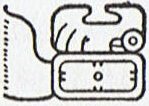5. South of the equator the seasons of the year are determined by the same sky roof as in the north, but when Ana-mua in Scorpio is rising in the east it is an event connected with the arrival of high summer and not with midwinter. And when Ana-muri in Taurus is reappearing it is a sign of winter and not of summer. The precession has moved the sky roof to a point where today Ana-mua is 16h 26m (slightly more because I am using information in a book from 1968) later than spring equinox north of the equator:
With 24 hours for a full cycle around the sun it means 986 / 1440 * 365.25 = 250 days after day number 80, i.e. day number 330:
South of the equator the day number of Ana-mua will be 266 + 250 - 365 = 151. For Ana-muri the day number will be 273 / 1440 * 365.25 + 80 = 69 + 80 = 149 north of the equator and 69 + 266 = 335 south of the equator:
I have here counted the day numbers from winter solstice, which means day number 151 will be 151 - 87 = 64 days after spring equinox and day number 335 will be 335 - 266 = 69 days later than autumn equinox:
A reversal is evident between Ga6-9 (as if alluding to 69 days after autumn equinox) and Ga6-10. In front lies the season of 'eating' (growth). Manu rere in Gb4-6 (where 4 * 6 = 24) has one fist at left held high (in the background) and one fist at left held low, signs which could refer to how Sun now is down in the Underworld. The signs are encouraging. However, we have not yet considered the effects of the precession. We have counted 18 years for a change in rectascension with 1 minute. A change in day number will therefore occur after about 4 * 18 = 72 years (and 26,000 / 365 = 71). If the G text was created e.g. 360 years ago we should reduce the day numbers accordingly, i.e. by 360 / 72 = 5 days:
This adjustment gives even better results. 22 is probably short for the close of a cycle (alluding to 22 / 7 = π) and Ga6-5 is a Sunday. Gb4-9 is a day of Jupiter and we can see someone going down. 4 * 9 = 36. Earlier (cfr at Moe) we have speculated if there could be a relationship between Kuukuu (Mars) and 156 days. Kara etahi in Gb4-8 is a day of Mercury, 7 * 26 = 182 days after moe in Ga6-6 (where 6 * 6 = 36):
... The grasping hand of the horizon in the west is a sign which explains the situation, and it has been used in Gb4-8 (though rotated in order to indicate a maximum of up):
|
||||||||||||||||||||||||||||||||||||||||||||||||||||||||||||||||||||||||||||||||||||||||||||||||||||||||||||||||||||||||||||||||||||||||||||||||||||||||||||||||||||||||||||||||||||||||||||||||||||||||||||||||||||||||||||||||||||||||||||||||||||||||















